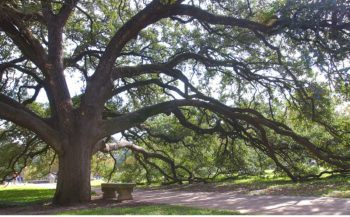Aggie Grad Turns Century Tree Acorns Into Funding Source For Aggie Scholarships
The Century Tree — or Century Oak, as it is widely known on campus — recently received “Famous Tree of Texas“ designation by the Texas Forest Service.

Money still doesn’t grow on trees, but a famous Aggieland tree’s acorns have produced seedlings that an enterprising Texas A&M graduate is growing with the goal of selling them to raise funds for a prestigious $100,000 scholarship at his alma mater.
The tree that produced the acorns that produced the seedlings is not just any tree. It is the Century Tree, a landmark on the Texas A&M campus and beloved by Aggies — many of whom have proposed to their future brides beneath its sprawling branches.
It’s not just Aggies who consider the tree famous. The Century Tree — or Century Oak, as it is widely known on campus — recently received “Famous Tree of Texas” designation by the Texas Forest Service.
The tree-growing Aggie is Andy Duffie, a 1978 Texas A&M graduate who resides in Vernon. He is growing 500 seedlings from the Century Tree and plans to sell them for $250 each (or two trees for $400) to fund a President’s Endowed Scholarship, the most prestigious scholarship awarded by the university.
Duffie, who holds a marketing degree from Texas A&M, harvested 3,000 acorns from the Century Tree in October 2010. Within weeks, 500 had sprouted. Duffie plans to sell the Century Tree seedlings to fellow Aggies in the fall of 2012 when the trees will be two years old and are expected to be 6 feet tall. He estimates that proceeds from his tree sales will raise the $100,000 endowment needed to fund the Century Tree President’s Endowed Scholarship.
As Texas A&M’s premier scholarship program, each President’s Endowed Scholarship is a permanent legacy that will benefit future generations of Aggies, university officials note. The scholarships are awarded to top students who excel in both academics and leadership potential.
Duffie says he is confident about the future success of his project. “In my opinion, Aggies will think it’s pretty awesome to have their very own Century Tree — especially Aggie couples who were engaged under the Century Tree on campus,” he notes. “These trees will be little pieces of Aggieland growing in yards across Texas. And outstanding Texas A&M students will benefit from the scholarship proceeds forevermore.”
Duffie already has more than 200 seedlings reserved by Aggies who are eager to have their own small part of campus history. He says the trees will be delivered to an off-campus site in College Station in the fall — and possibly to sites in the Dallas-Fort Worth and West Texas.
The project’s Facebook page, Aggie Century Tree Project, shows pictures of the trees at different stages of development and includes care and planting instructions. The trees can be reserved by contacting Duffie at centurytree@aggienetwork.com.
The Century Tree is believed to be one of the first trees planted on the campus of the state’s first public institution of higher learning, which opened in 1876. Many of its branches have grown so long and become so heavy that they now rest on the ground.
The “Famous Tree of Texas” designation is reserved for “an elite group of trees that have ‘witnessed exciting times in Texas frontier history’ and are alive today,” Gretchen Riley, the program’s coordinator, said in a letter notifying Texas A&M President R. Bowen Loftin of the campus tree’s inclusion in the select list.
Riley, staff forester for the Texas Forest Service, which is a member of The Texas A&M University System, explained that TFS initially included 87 “famous trees” in a book published in 1970.
“Sadly, Texas has lost many of these historic trees to the ravages of time,” she noted. “Only 56 remain.”
The Century Tree is one of only three trees added to the registry in the past 40 years, Riley said. She added it is the only formally designated “Famous Tree of Texas” located in the heart of a campus but pointed out that another, dubbed the “Kissing Oak,” is on land owned and utilized by Texas State University in San Marcos.
For more photos of the Century Tree, visit here.
